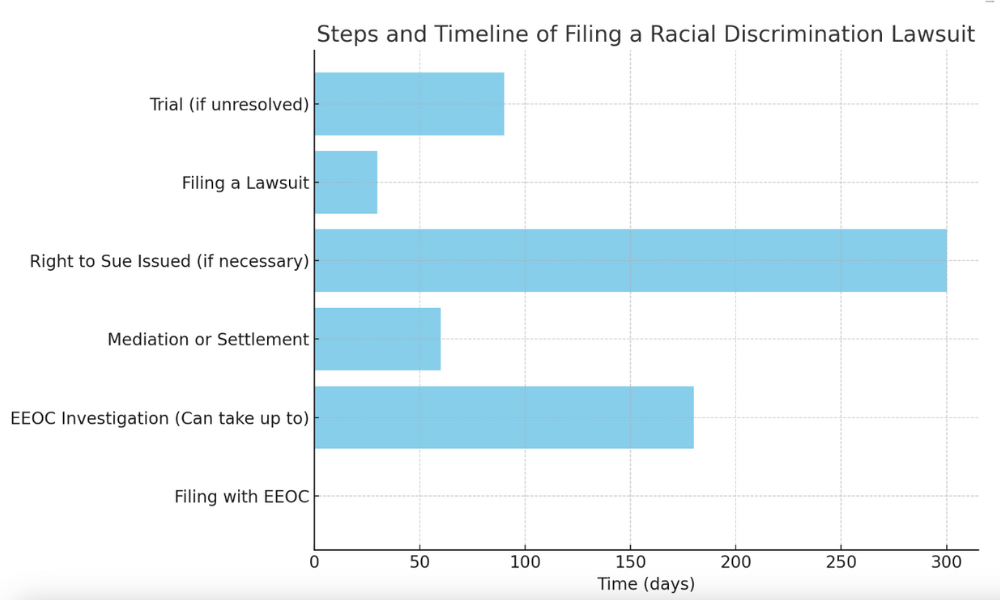Racial discrimination in the workplace is, unfortunately, a reality many employees still face today. But there are legal steps you can take to fight against it. If you’ve experienced unequal treatment based on your race, filing a racial discrimination lawsuit may be the best way to hold your employer accountable. In this article, we’ll break down what constitutes a racial discrimination lawsuit, when you should file one, and how to know if you have a strong case.
What Is a Racial Discrimination Lawsuit?
A racial discrimination lawsuit is a legal action taken by an individual who has experienced discriminatory treatment in the workplace because of their race. This can include unequal treatment in hiring, promotions, job assignments, termination, and other employment-related decisions.
In the United States, the primary legal framework protecting employees from racial discrimination is Title VII of the Civil Rights Act of 1964. This federal law prohibits discrimination based on race, color, religion, sex, and national origin. Under Title VII, employers are not allowed to make employment decisions that negatively impact an employee because of their race or ethnicity.
Protected Characteristics Under Federal Law
Federal law explicitly protects employees from discrimination based on race, color, and national origin. This means that employees of all racial and ethnic backgrounds are entitled to the same opportunities in hiring, pay, promotions, and work conditions. Employers cannot legally use your race as a reason for treating you differently from your coworkers.
For example, an employer cannot refuse to hire someone simply because they are Black, Asian, or Latino. Nor can they promote or fire employees based on these protected characteristics. Even seemingly “small” actions, such as being repeatedly assigned less desirable tasks due to your race, could qualify as racial discrimination.
State-Specific Laws in New Jersey and Pennsylvania
In addition to federal protections, states like New Jersey and Pennsylvania have their own laws that provide further protection against racial discrimination.
- New Jersey Law Against Discrimination (NJLAD): This law prohibits discrimination based on race, color, national origin, and several other protected categories. NJLAD offers broad protections, allowing employees to file claims even for discriminatory actions not covered under federal law.
- Pennsylvania Human Relations Act (PHRA): Pennsylvania also has strong anti-discrimination protections through the PHRA, which covers discrimination in employment, housing, and public accommodations. Under the PHRA, employees are safeguarded against racial discrimination in the workplace and have the right to file a complaint with the Pennsylvania Human Relations Commission.
Both of these state laws provide additional avenues for employees to seek justice, sometimes offering more specific protections or longer filing deadlines than federal law.
Common Types of Racial Discrimination in the Workplace
Racial discrimination can take many forms. Below are some of the most common ways it occurs in the workplace:
- Hiring Practices: Refusing to hire a qualified candidate because of their race.
- Promotions: Denying promotions or opportunities for advancement to employees of a certain race, even when they are qualified.
- Termination: Firing or laying off employees based on their race rather than their performance.
- Hostile Work Environment: Subjecting an employee to racial slurs, jokes, or other discriminatory behaviors that create an intimidating or offensive work environment.
In each of these situations, the discriminatory action is illegal and may serve as the basis for filing a racial discrimination lawsuit.
Filing a Racial Discrimination Lawsuit: When and How to File
Before filing a racial discrimination lawsuit, there are certain criteria that must be met.
One of the first steps is to file a charge with the Equal Employment Opportunity Commission (EEOC). The EEOC is the federal agency responsible for enforcing anti-discrimination laws. In most cases, filing with the EEOC is a prerequisite before you can take your case to court. After reviewing your case, the EEOC may issue a Notice of Right to Sue, which allows you to proceed with a lawsuit.
The EEOC requires that you file a charge of discrimination within 180 days of the discriminatory action. This deadline is extended to 300 days if your case is covered by state or local laws, such as NJLAD or PHRA.
Filing a lawsuit involves gathering evidence to support your claim and presenting it in court. To build a strong case, you’ll need documentation such as:
- Emails or written correspondence showing discriminatory behavior
- Witness statements from coworkers or others who have witnessed the discrimination
- Performance reviews or employment records that demonstrate you were treated differently because of your race
Your lawyer can help you gather and present this evidence effectively.

Steps And Timeline Of Filing A Racial Discrimination Lawsuit
Timing for Filing a Racial Discrimination Claim
Filing deadlines are critical when it comes to racial discrimination lawsuits. If you fail to file your claim within the set timeframes, you may lose your right to pursue legal action.
The Equal Employment Opportunity Commission (EEOC) requires that a racial discrimination claim be filed within 180 days of the discriminatory act. However, in states with local or state anti-discrimination laws—like New Jersey and Pennsylvania—this period is extended to 300 days. In New Jersey, this extension aligns with the New Jersey Law Against Discrimination (NJLAD), while in Pennsylvania, the Pennsylvania Human Relations Act (PHRA) offers a similar extension.
Being aware of these deadlines is crucial because missing them could mean losing your chance to file a claim. If you’re uncertain about how much time you have, it’s always best to consult a lawyer as soon as possible.
Gathering Evidence for a Strong Case
Building a solid case hinges on collecting the right evidence. The success of a racial discrimination lawsuit often depends on the strength of your documentation and witness testimony.
Some key forms of evidence include:
- Emails or messages that show discriminatory remarks or bias in job-related decisions.
- Witness statements from colleagues who observed discriminatory behavior.
- Performance reviews that show a pattern of unfair treatment compared to coworkers of different races.
- Direct evidence: This is straightforward proof, such as a racist comment made by a supervisor or written policies that favor one race over another.
- Circumstantial evidence: In the absence of direct proof, circumstantial evidence can be powerful. For example, if an employee of a certain race is repeatedly passed over for promotions in favor of less qualified individuals of a different race, this can be considered circumstantial evidence.
Your lawyer will help you gather and organize this evidence, ensuring it meets legal standards for admissibility in court.
Understanding the Burden of Proof
In a racial discrimination lawsuit, the burden of proof falls on the employee (the plaintiff) to show that their race was the primary factor in the discrimination they faced. This can be demonstrated through either direct evidence or circumstantial evidence.
When direct evidence is unavailable, the courts may use a legal standard known as the McDonnell Douglas burden-shifting framework. This three-part test is commonly used in employment discrimination cases:
- Prima Facie Case: The employee must first show that they are a member of a protected class and that they experienced adverse treatment in the workplace.
- Employer’s Defense: The employer then has the opportunity to provide a legitimate, non-discriminatory reason for the treatment (e.g., poor job performance).
- Pretext: The burden shifts back to the employee to prove that the employer’s reason is just a pretext for discrimination.
This process emphasizes the importance of having well-documented evidence and a strong legal argument to support your claim.
Legal Process: From Filing to Court
The legal process for filing a racial discrimination lawsuit typically begins with the EEOC. Here’s a breakdown of the steps involved:
- Filing with the EEOC: Before suing, you must first file a complaint with the EEOC. The agency will investigate your claim to determine whether your case has merit.
- EEOC Investigation: The EEOC may conduct interviews, review documents, and request additional information from both the employee and employer.
- Mediation or Settlement: In many cases, the EEOC will attempt to mediate a settlement between you and your employer to avoid a lengthy trial.
- Right to Sue: If the EEOC’s investigation supports your claim—or if they do not resolve the case within a certain time frame—they will issue a Notice of Right to Sue, allowing you to file a lawsuit in federal court.
- Filing a Lawsuit: Once you have the right to sue, your lawyer will formally file the lawsuit. This initiates the legal proceedings, where evidence will be presented, and arguments made.
- Trial: If the case doesn’t settle, it may go to trial, where a judge or jury will determine whether discrimination occurred and what compensation, if any, should be awarded.
Navigating this process can be complicated, but a skilled lawyer will guide you every step of the way.
Settlement vs. Trial: What’s the Difference?
In many cases, a settlement is reached before a racial discrimination lawsuit goes to trial. A settlement occurs when both parties agree on compensation without continuing to court. Settlements are typically quicker and less costly than a trial, but the outcome may be less than what could potentially be won at trial.
On the other hand, going to trial can lead to a larger compensation award but involves a longer, more public legal process. A lawyer helps you weigh the pros and cons of each path and will negotiate on your behalf for a fair settlement or represent you in court if needed.

An attorney consulting with a client about filing a racial discrimination lawsuit, reviewing evidence and documentation in a law office.
Compensation in Racial Discrimination Lawsuits
If your racial discrimination lawsuit is successful, you may be eligible for several types of compensation, including:
- Back Pay: Compensation for wages or benefits lost due to discrimination, such as missed promotions or unjust termination.
- Punitive Damages: In cases where the employer’s behavior is especially egregious, punitive damages may be awarded to punish the employer and deter future discrimination.
- Emotional Distress Compensation: Compensation for the emotional harm, such as stress or anxiety, that you experienced due to the discrimination.
- Reinstatement: In some cases, the court may order your employer to reinstate you to your previous position if you were unfairly terminated.
The goal of compensation is not only to make up for what was lost but also to hold the employer accountable for their discriminatory actions.
Protections Against Retaliation
Filing a discrimination complaint can be intimidating, especially if you’re concerned about retaliation. Fortunately, both federal and state laws protect employees from being punished for asserting their rights.
Under Title VII and state laws like NJLAD and PHRA, it’s illegal for an employer to retaliate against an employee for filing a complaint, participating in an investigation, or standing up against discrimination. Retaliation can take many forms, including:
- Demotion
- Salary reduction
- Unfair performance evaluations
- Termination
If you experience retaliation after filing a complaint, you may have grounds for an additional legal claim. Your lawyer can help you document and pursue this.
Indicators of a Strong Racial Discrimination Case
Certain factors make a racial discrimination case stronger. These include:
- Recurring Incidents: If you’ve faced discrimination on multiple occasions, your case is more likely to succeed than if it was an isolated event.
- Consistent Unequal Treatment: Showing that you were consistently treated worse than employees of a different race, despite similar qualifications or job performance, strengthens your claim.
- Patterns of Discrimination: If other employees of the same race experienced similar treatment, this can serve as evidence of a broader discriminatory practice within the company.
If you’re unsure whether you have a strong case, consulting with a lawyer can help clarify your options.
Why Hiring a Lawyer Is Crucial
Navigating a racial discrimination lawsuit without legal help can be overwhelming. An experienced employment discrimination lawyer not only helps you understand your rights but also ensures that your case is filed correctly and that all necessary evidence is presented effectively.
In complex or subtle cases of discrimination, having a lawyer on your side increases your chances of success. Your lawyer will guide you through the legal process, negotiate on your behalf, and fight to secure the compensation you deserve.
Call to Action: Get Legal Help Today
If you believe you’ve been the victim of racial discrimination in the workplace, don’t wait to seek help. The sooner you act, the better your chances of securing justice. Contact Swartz Swidler LLC today for a free consultation and let our experienced attorneys fight for your rights. We are here to help you navigate the legal process and protect you from further harm.






